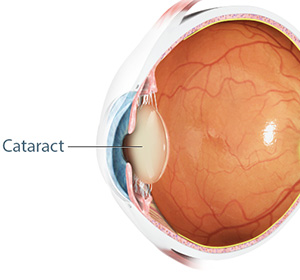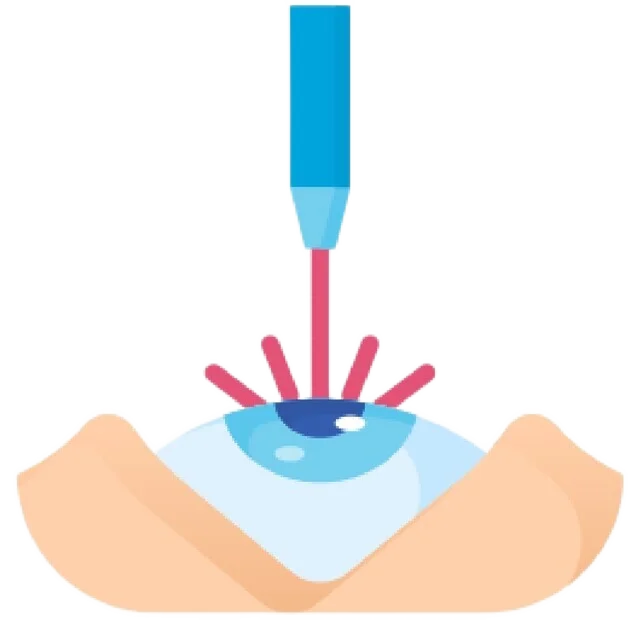
What is Cataract?
A cataract is a condition which causes clouding of the lens in the eye resulting in blurry vision. The lens is situated behind the iris, the dark portion of the eye, and is not visible. When a cataract occurs, the lens becomes cloudy and is seen as a white cloudy ball in the centre of the iris. The lens is made up of mostly water and proteins. These specific proteins provide its transparent structure. Any structural change in these proteins can alter the clarity of the lens and negatively impact vision.
Three types of cataracts classified according to their location in the eye.
- A nuclear cataract is when the cloudiness is present in the centre of the lens.
- With the Cortical cataract, the cloudiness is seen in the outer peripheral region or cortical region of the lens.
- A subcapsular cataract occurs at the back of the lens capsule or subcapsular region. This type develops quicker and can appear more suddenly than nuclear and cortical cataract.
Cataracts are also classified according to the cause, either as age-related cataract, congenital cataract, secondary cataract or traumatic cataract.
Causes of Cataracts
A cataract can occur due to many reasons.
- Age: As people age, changes can occur in the structure of the lens protein leading to cataract.
- Congenital: Cataract can occur in newborns as inherited disorder or can develop in infants because of infections in mother during pregnancy such as rubella, herpes simplex, and syphilis.
- Secondary causes: Cataract can form as a complication of other diseases such as glaucoma and diabetes. Prolonged use of corticosteroid inhalers and eye drops increases the risk of cataract.
- Trauma: Certain injuries may result in the formation of a cataract. A cataract may also develop years after the injury.
Other causes:
- Excessive exposure of the eyes to UV rays
- X-rays
- Other radiation during radiotherapy.
Cataracts usually develop very slowly and are not associated with any pain or redness of the eye. Your vision gradually becomes blurred as if you are looking through the dirty lens of a camera. Some patients may see a halo around bright lights. Others find the glare from the sun and headlights of approaching cars at night annoying. Some patients present with double vision in one of the eyes and the colours appear dull or muted. In others, frequent prescription changes for glasses or contact lens may become necessary.
Diagnosis for Cataracts
To assess the impact of cataract on your vision your doctor will perform a Visual Acuity Test where the patient reads an eye chart from a particular distance with one eye at a time. The doctor then examines the cornea, iris, and lens individually using an intense ray of light from a slit lamp to detect any abnormalities. For the retinal exam, eye drops are added to dilate the eye and the retina is examined for any abnormalities using an ophthalmoscope.
Treatments for Cataracts
Surgery is the only treatment for cataract and is recommended based on the severity of the disease and the impact on the daily activities of the patient. The patient usually makes the decision to have surgery when the symptoms negatively impact their lifestyle.
Surgery is performed on one eye at a time with a few weeks gap in between the two operations. Cataract surgery is done on an outpatient basis where the patient can go home the same day. The eye and area around the eye are numbed using local anaesthesia. The cloudy lens is removed and replaced with a clear plastic lens in the same lens capsule as the natural lens.
What is M plus Lens?
M plus Lens is a new type of IOL (Intra Ocular Lens) used in cataract patients that enables the patients to view both far distance and near distance objects without using glasses. Traditionally, mono-focal lenses were used in cataract surgery where the patient was able to see far distance objects with the new artificial lens implanted during surgery but they required additional glasses or lenses to enable them to see near distance objects or to read. LENTIS M plus is a multi-focal lens that gives you a clear vision for far, mid and near-range objects and helps you to perform your daily activities. Apart from cataract surgery, the M plus lens is also used for patients with short-sightedness, long-sightedness, astigmatism, and presbyopia.
Advantages of M plus lens
The Lentis M plus lens has the following advantages:
- No possibility of developing cataracts
- Normal magnification level
- Provides full peripheral or side vision
- The permanent solution to your focussing problems
- Excellent contrast sensitivity
- Produces good vision regardless of your pupil size
- Has reduced glare and haloes
- Performs well in all lighting conditions
Following surgery, your doctor will prescribe eye drops to prevent infection and inflammation. A follow-up visit is scheduled to monitor healing and to check for any complications from surgery.







